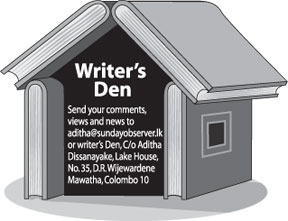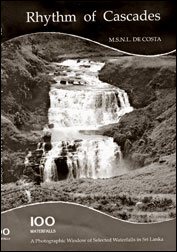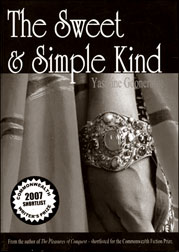|

Debate:
‘Sri Lankan writers struggle to write in English because they have
an inferiority complex’ - Dr. Gunadasa Amarasekara
by Aditha Dissanayake
[email protected]
|

Dr. Amarasekara’s theory is simple. “Writers, through their
creative work, cannot address the universe...”
|
Grave were the accusations he had made in a Sinhala paper, last
Sunday (March 30) regarding writers who write in English, I was caught
off-guard when I found Dr. Gunadasa Amarasekara in a jovial mood, when I
finally traced him at his residence in Nawala last Wednesday.
With laughter in his voice he admits to having spoken to a journalist
sometime ago about Sinhala writers who write in English, but chuckles
saying he did not see the article last Sunday. He stands by the
statement he had made. “Yes, Sri Lankan writers write in English because
they have an inferiority complex”.
Dr. Amarasekara’s theory is simple. “Writers, through their creative
work, cannot address the universe. When you write a creative work you
get into a dialogue with the public. You are communicating with an
audience - you are addressing the people of your country” says Dr.
Amarasekara. “And when you address the people of your country you must
use the language of the people of your country”.
He dismisses the belief Sinhala writers should write in English to
reach out to the universe, as bunkum. Quoting one of his favorite
authors, he says only two people in this world can address the universe,
the President of the United States and the Pope. All others can address
only their own people and to do so they should use their mother tongue.
“All this emphasis on writing in English is due to a new form of
colonialism spreading its wings over the country” adds Dr. Amarasekara.
“Those who struggle (yes, he emphasises the word -struggle) to write in
English do so because they have an inferiority complex”. Period.
Over to all Sri Lankan writers in English out there. This space is
yours. Do you think he is right?
Fact file
Born in a village near Galle, the novelist, short story writer, poet,
literary critic and essayist Gunadasa Amarasekara is considered one of
the founding fathers of modern Sinhalese literature.
He is also considered one of its more controversial writers as he
examines hypocritical politicians and “self-centered intellectuals.”
Amarasekara revolutionized Sinhalese poetry with a new poetic form
evolved from Sri Lanka’s folk poetry. A dentist by training, Amarasekara
began writing while a student at the Dental School in Peradeniya.
In the early fifties, his short story Soma was selected to represent
Ceylon in a world short story competition organized by the New York
Herald Tribune. It was published in the collection of World Prize
Stories in 1952. This was the beginning of his illustrious literary
career that spans over 50 years.
By the mid 1950s he was a leader of the new Peradeniya School of
Poets. Increasingly rejecting foreign literary influences, he developed
a distinct Sinhalese short story form. His stories deal mostly with the
social and cultural aspects of the middle class.
His first novel, Karumakkaarayo, triggered controversy as he examined
a power hungry politician and showed “the beginning of his tribal
warfare in its incipient stages, in the guise of village-politics in a
remote village in the South.”
Beginning in the mid-1970s, he ventured into a field of social,
cultural and political criticism and continues in his role of social
activitist and commentator. His seven-volume narrative Gamanaka mula
examines the evolution of middle class Sri Lanka and enunciated the
concept of Jaatika chintanaya (national consciousness).
The Library of Congress has thirty-two works by him.
Source: Library of Congress website
Of rapids, cascades and waterfalls
Reviewed by Prof. Kapila Dahanayake
 The writer Sunil de Costa had been enamoured by the beauty and the
variety of waterfalls in Sri Lanka while he climbed hill slopes as part
of his professional exercise of duties as a magistrate. The writer Sunil de Costa had been enamoured by the beauty and the
variety of waterfalls in Sri Lanka while he climbed hill slopes as part
of his professional exercise of duties as a magistrate.
No doubt his adroit handling of the camera had resulted in more than
100 eye catching as well as informative photographs of spectacular
geological phenomenon that is waterfalls. For a geologist, photographs
are ofcourse no replacement for a field visit to such sites.
But I have been able to observe many geological features in this book
thanks to the clarity of the photographs, their accurate descriptions
and above all the adroit handling of the camera by the author.
Waterfall is a geological formation resulting from water often in the
form of a stream flowing over an erosion resistant rock that developed a
sudden break in elevation. Where a bed of strong rock more resistant to
natural processes of weathering and erosion-horizontal or gently
inclined upstream is underlain downstream by a weaker rock formation,
the initial stages of waterfall development commences. A rock formation
is considered as weak due to its particular composition and or
structures (fractures/faults).
In the wide spectrum of waterfalls, three types could be recognized:
rapids, cascades and waterfalls based on the (a) steepness of the
gradient (b) continuity or discontinuity of the gradient.
A part of a stream where the current is moving with a greater
swiftness with the water surface being broken by obstru ctions but
without sufficient break in slope to form a waterfall refers to rapids
(Fig 1). When the vertical fall of a waterfall is interrupted by a
series of benches (like on a stairway) a series of relatively small
waterfalls occur sometimes with individual plunge pools and these are
the cascades sensu stricto (Fig. 2).
A stream flowing on strong rock strata underlain by weaker rocks will
initially form rapids that will gradually erode the stream bed to give
rise to a steep gradient along a fracture/fault plane (Fig.3).
The water flowing along such a river when it encounters a steep slope
plunges at high speed foaming and forming in the process a spectacular
sight of a column of turbulent flow which is a waterfall sensu stricto
(Fig.3). At the foot of the waterfall is a plunge pool where very large
pot holes cut into the rock (Fig.3).
These vertical holes are developed as water plunges down with force
through turbulent flow accompanied by its “drilling” tools-boulders,
pebbles, sand and silt. Such pools are visible particularly on several
pages e.g. 38,54,58,62,64,70,74 of the book.
Waterfalls can be seen in the hilly terrains of Sri Lanka. These
areas are underlain by mostly metamorphic rocks such as gneisses,
quartzite, marble and charnockite. Charnockite form massive rocks
resistant to weathering and erosion processes.
They can form steep and deep vertical slopes and when stream plunges
over their crests a waterfall will form. Gneisses can be of different
compositions and structures and as such they may give rise to series of
nearly horizontal benches/tables (Fig. 2).
The author starts his expose on waterfalls by considering Ranmudu
Falls in Colombo district which flow as three small waterfalls at
different elevations, His discourse on the Rhythm of Cascades thus
commences by aptly introducing the readers - perhaps unwittingly using
the correct geological parlance - to a stepped series of closely spaced
small waterfalls descending over the crests of steeply slanting
resistant rocks (Fig. 2). The naming of at least some waterfalls is in
recognition of these facts.
Hath Mala Ella - Seven Storey Falls (p.46) is a case in point and
evidence for indigenous knowledge about waterfalls. Such small
waterfalls are the “cascades” sensu stricto. In the waterfall
development there are three stages which do not appear as a regular
development of events - smallest being rapids, then cascades and finally
the waterfalls (Figs. 1,2,3).
In this hierarchy - the shallow angle of the face of resistant rock
becomes gradually increased from near horizontal until it appears as a
very steep or vertical precipice over the crest of which a waterfall
descends in its majestic beauty (Fig. 1).
In the world context of waterfalls, Angel Falls of Venezuela is
world’s highest at 979m, Africa’s Victoria Falls is world’s longest at
over 1 mile with North America’s Niagara Falls being the largest in
terms of volume of water flowing over the precipice. Sri Lanka’s tallest
is Bambarakanda (241m) followed by Kurundu Oya (189m) and Diyaluma
waterfalls (171m). The Bambarakanda fall has the rank of 48 in the
world.
Yet, Sri Lankan waterfalls in their characteristic tropical highland
settings with luxuriant vegetation are indeed as picturesque and are
perhaps of unsurpassed beauty. These are sites visited by multitudes of
even Sri Lankan tourists and indeed by many a foreign tourist.
In his treatise, Mr. Costa has taken one and all on a sightseeing
mission by his beautiful photographs of Sri Lankan waterfalls and their
captivating captions.
A significant number of these waterfalls in Sri Lanka can be
categorized as cascades. The author has done justice to his work by
aptly describing the publication as “Rhythms of Cascades” It is indeed a
landmark contribution which opens a window for those who would
appreciate the beauty of waterfalls.
Congratulations to author Sunil Costa for a very useful and valuable
academic exercise!
The sweet and simple kind - shortlisted for the 2008 IMPAC Dublin
literary award
 Eight novels, including “The sweet and simple kind” by Yasmine
Gooneratne, have made the shortlist for the 2008 International IMPAC
Dublin Literary Award. Eight novels, including “The sweet and simple kind” by Yasmine
Gooneratne, have made the shortlist for the 2008 International IMPAC
Dublin Literary Award.
The shortlist was selected from a total of 137 novels nominated this
year. The Award is worth €100,000 and is the world’s most valuable
literary prize for a single work of fiction published in English. The
eight shortlisted novels are among 137 nominated by 162 public library
systems in 122 cities worldwide.
The Lord Mayor and Patron of the Award, Cllr. Paddy Burke, officially
confirmed the eight novels on this year’s shortlist on April 2, 2008
The list is as follows:
* The Speed of Light - Javier Cercas (Spanish) in translation
* The Sweet and Simple Kind - Yasmine Gooneraratne (Sri Lankan)
* De Niro’s Game - Rawi Hage (Lebanese)
* Dreams of Speaking - Gail Jones (Australian)
* Let It Be Morning - Sayed Kashua (Israeli) in translation
* The Attack - Yasmina Khadra (Algerian) in translation
* The Woman Who Waited
* Andrei Makine (Russian) in translation
* Winterwood - Patrick McCabe (Irish)
“The themes of the 2008 shortlisted titles are international and
include war, love, terrorism, politics, religion, family and murder,
says Deirdre Ellis King, Dublin City Librarian. Nominated by public
libraries in Australia, Canada, Finland, France, Ireland, Lebanon, Sri
Lanka and the USA, they prove that such a high standard of literature
can be read and appreciated by anyone.
A judging panel of five, chaired by non-voting former Chief Judge of
a US Court of Appeals, Hon. Eugene R. Sullivan, will select one winner
from the eight novels shortlisted. (The winner will be announced by The
Lord Mayor, Cllr. Paddy Bourke, Patron of the Award, in City Hall on
12th June 2008.
The International IMPAC Dublin Literary Award is managed by Dublin
City Libraries, on behalf of Dublin City Council. It is sponsored by
IMPAC, an international management productivity company with its
European headquarters in Dublin.
The Award is presented annually with the objective of promoting
excellence in world literature.
It is open to novels written in any language and by authors of any
nationality, provided the work has been published in English or English
translation in the specified time period as outlined in the rules and
conditions for the year.
Nominations are submitted by library systems in major cities
throughout the world.
‘Through Deep Waters’
 Capt. Priyantha de Silva, a veteran master mariner’s novel ‘Through
Deep Waters’ will be launched on 7th April at 5.00 p.m. at the Sri Lanka
Foundation Institute. Capt. Priyantha de Silva, a veteran master mariner’s novel ‘Through
Deep Waters’ will be launched on 7th April at 5.00 p.m. at the Sri Lanka
Foundation Institute.
‘Through Deep Waters’ unfolds the eventful years spent by a Sri
Lankan sailing over the seven seas of the world. He captures vividly the
thrills, joys and the agony of meeting, interacting and parting with
many a soul from different walks of life, from different continents,
during his extraordinary journeys round the globe.
“Through Deep Waters’ this master mariner reminiscences his journey
from the very beginning. It is not only about the life and experiences
at sea but also on dry land. The pages of ‘Through Deep Waters’ carry a
message to readers of all ages. Media consultant Edwin Ariyadasa will
deliver the keynote address whilst Edmund Jayasuriya and E. M. G.
Edirisinghe will evaluate the new book. Veteran media personality Daya
Abeysekara will conduct the proceedings. |
